|
|
 |
Fiche d'espèce de Copépode |
|
|
Calanoida ( Ordre ) |
|
|
|
Metridinidae ( Famille ) |
|
|
|
Pleuromamma ( Genre ) |
|
|
| |
Pleuromamma indica Wolfenden, 1905 (F,M) | |
| | | | | | | Ref.: | | | Wolfenden, 1905 (1906) (p.1011, Descr.F,M, figs.M); Pesta, 1913 (p.33, fig.F); Sewell, 1932 (p.264, figs.F); Steuer, 1932 a (p.17, 47, 61, 74); 1933 (p.9, figs.F,M); Sewell, 1947 (p.168, Rem.); Delsman, 1949 (p.129); Grice, 1962 (p.215, figs.M); Tanaka, 1963 (p.24, figs.F,M); Saraswathy, 1966 (1967) (p.80); Ferrari, 1984 a (p.168, 170, Rem.); 1985 (p.19, 20, Rem.); J.S. Park & Mauchline, 1994 (p.108 & suiv., fig.F); Beckmann, 1995 (in Monoculus, n°29, p.6); Chihara & Murano, 1997 (p.839, tab.7); Böttger-Schnack & al., 2004 (p.1134: Rem.); Conway & al., 2003 (p.93, figs.F,M, Rem.) | 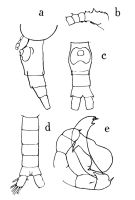 issued from : O. Tanaka in Publs Seto Mar. Biol. Lab., 1963, XI (1). [p.25, Fig.160]. Female: a, urosome (left lateral side); b, basal part of A1; c, urosome (ventral). Nota: The urosome segments and furca in the proportional lengths as 47:21:16:16 = 100. A1 extends to the posterior margin of the genital somite. Male: d, urosome (dorsal); e, P5. Nota: The pigment spot on the right side; In P2 the first segment of the endopod notched on the left side.
|
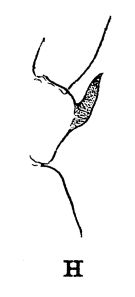 issued from : R.B.S. Sewell in The John Murray Expedition, 1933-34, Scientific Reports, VIII (1), 1947. [p.166, Fig.44, H]. Process on the posterior aspect of the 2nd basal segment of P1. Remarks: The shape of the hook-like or spine-like process shows some variation in different genera, but it is undoubtedly homologous throughout the whole series. The function of this organ is unknown.
|
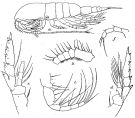 Issued from : R.B.S. Sewell in Mem. Indian Mus., 1932, X (continued). [p265., Fig.89]. Female (from Laccadive Sea): a, habitus (lateral left side); b, proximal segments of A1; c, Mxp; d, P2; e, P3; f, P5.
|
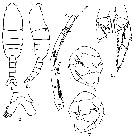 issued from : G.D. Grice in Fish. Bull. Fish and Wildl. Ser., 1962, 61. [p.217, Pl.22, Figs.1-7]. Male (from 00°29'N, 139°49'E)): 1-2, habitus (dorsal and lateral, respectively); 3, anal segment and caudal rami (dorsal); 4, segments 17 to 23 of right A1; 5, P2 (only part ); 6, P5 (anterior); 7, same (posterior). Nota: Abdomen symmetrical; divergent caudal rami; absence of teeth on segment 17 of the right A1. The 1st segment of both endopods of P2 are indented and claw-like (this claw-like indentation in P. abdominalis on only one endopod).
| | | | | Ref. compl.: | | | Sewell, 1948 (p.329, 521, 527, 530); Grice & Hulsemann, 1967 (p.17); Vinogradov, 1968 (1970) (p.277); Timonin, 1971 (p.281, trophic group); Patel, 1975 (p.659); Tranter, 1977 (p.596, 602); Sreekumaran Nair & al., 1981 (p.493); Madhupratap & al., 1981 (p.262, Table 2: abundance vs. thermocline, Rem.: p.263); Madhupratap & al., 1981 (p.266, fig.1a: abundance vs. geographic transect); Stephen, 1984 (p.161, 169, Distribution vs. thermocline & geographic); Almeida Prado Por, 1985 (p.250); Brinton & al., 1986 (p.228, Table 1: Rem.: uncertainty); Chen Y.-Q., 1986 (p.205, Table 1: abundance %, fig.9, Table 2: vertical distribution); Saraswathy, 1986 (p.186); Saraswathy & Krishna Iyer, 1986 (p.219, abundance vs geographic distribution & O2 minimum); Madhupratap & Haridas, 1986 (p.105, tab.1); Echelman & Fishelson, 1990 a (tab.2); Jiyalal Ram & Goswami, 1993 (p.129, tab.IV); Madhupratap & al., 1996 (p.866); Padmavati & Goswami, 1996 a (p.85, Table 4, vertical distribution); Padmavati & al., 1998 (p.349, 352); Madhupratap & al., 2001 (p. 1345, vertical distribution vs. O2, figs.4, 5: clusters, p.1353); Farstey & al., 2002 (p.97, fig.5); Gallienne & al., 2004 (p.5, tab.3); Kazmi, 2004 (p.228, Rem: p.232); Smith & Madhupratap, 2005 (p.214); Cornils & al., 2007 (p.278, Table 2); Prusova & Smith, 2005 (p.75); Fernandes, 2008 (p.465, Tabl.2); McKinnon & al., 2008 (p.844: Tab.1); Wishner & al., 2008 (p.163, Table 2, fig.8, oxycline); Selifonova & al., 2008 (p.305, Tabl. 2); Selifonova, 2011 a (p.77, Table 1, alien species in Black Sea); Pillai H.U.K. & al., 2011 (p.239, Table 3, vertical distribution); Naz & al., 2012 (p.61, Table 4, relative abundance); Gubanova & al., 2013 (in press, p.4, Table 2); in CalCOFI regional list (MDO, Nov. 2013; M. Ohman, comm. pers.) | | | | NZ: | 8 + 1 douteuse | | |
|
Carte de distribution de Pleuromamma indica par zones géographiques
|
| | | | | | | | |  issued from : M. Saraswathy in Mahasagar-Bull. Nat. Inst. Oceanogr., 1986, 19 (3). [p.187, Fig.1A]. issued from : M. Saraswathy in Mahasagar-Bull. Nat. Inst. Oceanogr., 1986, 19 (3). [p.187, Fig.1A].
Distribution of P. indica in the Indian Ocean (upper water column of 200 m).
Triangle: South West Moonsoon season: April 16 to October 15 (white triangle = negative stations; black = animals collected). Circle: North East Moonsoon season: October 16 to April 15 (white circle = negative stations; black = numbers of ianimals collected).
Nota: High densities were recorded in the area north of 10°N the Gulf of Oman and in the central Bay of Bengal. Towards the south it extends to 10°S in moderate numbers and further south the number decreases considerably and the species is completely absent south of 30°S except along the South African coast. Maximum number in a standard haul was obtained from a night station during the NE monsoon season, located near the mouth of the Gulf of Oman. |
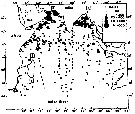 Issued from : M. Saraswathy & H. Krishna Iyer in Indian J. Mar. Sci., 1986, 15. [p.219, Fig.1] Issued from : M. Saraswathy & H. Krishna Iyer in Indian J. Mar. Sci., 1986, 15. [p.219, Fig.1]
Distribution of P. indica (Number per haul based on standard collections (mosthy 200-0 m) in the indian Ocean.
Nota: Zooplankton collections taken from The Indian Ocean during the International Indian Ocean (IIOE 1962-1965).
For the authors P. indicashowed a positive correlation with salinity and phosphate and a negative relationship with dissolved oxygen. Measurement of specimens from different areas showed that individuals from the locality whjch had the maximum density of the species were slightly smaller in size when compared to those from other areas. The females ranged from 1.6 to 2.8 mm, the smallest being in the area of the Gulf of Oman. Males ranged from 1.5 to 2.1 mm.
The position of the pigment spot was found to vary in males in relation to the position of geniculate antennule. When the geniculate A1 was on the right side, pigment spot was found on the left and vice versa. In females also the spot was either on the left or on the right side.
It appears that P. indica which is the only one in the genus which can survive in a nutrient rich environment of high salinity and low oxygen, had taken advantage of the upwelling, to produce dense populations of the species in the northern areas of the Arabian Sea. |
 Issued from : M. Madhupratap, S.R. Sreekumaran Nair, C.T. Achuthankutty & V.R. Nair in Indian J. Mar. Sci., 1981, 10. [p.267, Fig.1a, b, c]. Issued from : M. Madhupratap, S.R. Sreekumaran Nair, C.T. Achuthankutty & V.R. Nair in Indian J. Mar. Sci., 1981, 10. [p.267, Fig.1a, b, c].
Distribution of copepod species in the Andaman Sea (around Andaman-Nicobar Islands). a: Pleuromamma indica; b: Aetideus giesbrechti; c: Eucalanus (= Subseucalanus) mucronatus.
Samples collected in vertical hauls (200-0 m) using a net (mesh aperture 500 µm). Cf. Madhupratap & al., 1981: Indian J. Mar. Sci., 10, p.258.
No. = number of individuals. |
 Issued from : Y.-Q. Chen in CalCOFI Rep., 1986, XXVII. [Fig.9, p.217]. Issued from : Y.-Q. Chen in CalCOFI Rep., 1986, XXVII. [Fig.9, p.217].
Vertical abundance of females, males and late copepodites.
Nota: The numbers of this species were the highest for the genus Pleuromamma during the Krill Expedition in the Pacific east tropical (23°N to 3°S). The species was found at most of the stations. Females occurred primarily between 250 and 600 m during the day. The depths of maximum concentrations were from 350 to 400 m between 6°N and 8°N. Maximum numbers were 2800 individuals/1000 3.
Female vertical distribution at night was from 150 to 300 m between 20°N and 3°N. It appears that vertical distribution was shallower north of 12°PN than south of this latitude. The data suggest that the species undergoes diel vertical migration.
The mean percentage combined was 1.8% (day: 0.6, night: 3.0) for all samples with the bongo net .
See in Subeucalanus subtenuis Chart of stations figs.1, Hydrographic conditions Figs. 12, 13). |
| | | | Loc: | | | South Africa (W & S), W Black Sea (alien species), G. of Aqaba, Red Sea, G. of Oman, Arabian Sea, Karachi coast, off SE Madagascar, Rodrigues Is. - Seychelles, Mascarene Basin, NW India (Saurashtra coast), W India (Goa - Gujarat), E India, Bay of Bengal, Andaman Sea (Barren Island), Australia (W, North West Cape), Indonesia-Malaysia (Sunda Strait); Japan (Sagami Bay), off SE Japan, ? Gulf of California (in Brinton & al., 1986, p.228, Table 1); | | | | N: | 53 ? | | | | Lg.: | | | (26) F: 2,41-2,2; M: 1,96; (44) F: 2-1,7; (78) F: 2,5-2,3; M: 2,05-2; (101) M: 2,04; (530) F: 2; (991) F: 2,06-2,72; M: 1,65-2,38; (991) F: 2,06-2,72; M: 1,62-2,38; (1047) F: 2,0; (1194) F: 1.6-2.8; M: 1.5-2.1; {F: 1,70-2,72; M: 1,65-2,38}
The mean female size is 2.219 mm (n = 14; SD = 0.3730), and the mean male size is 1,968 mm (n = 10; SD = 0.3002). The size ratio (male : female) is 0.84 (n = 5; SD = 0.0122). | | | | Rem.: | Timonin (1971, p.282) considers the trophic interrelations in the equatorial and tropical Indian Ocean, and divides the plankters into 6 trophic groups from the litterature and the results of studies of mouth-parts structure and intestine content. This species is omnivorous.
See in DVP Conway & al., 2003 (version 1)
: R. Stephen, 2007 : Data sheets of NIO, Kochi, India (on line). | | | Dernière mise à jour : 18/11/2020 | |
|
|
 Toute utilisation de ce site pour une publication sera mentionnée avec la référence suivante : Toute utilisation de ce site pour une publication sera mentionnée avec la référence suivante :
Razouls C., Desreumaux N., Kouwenberg J. et de Bovée F., 2005-2025. - Biodiversité des Copépodes planctoniques marins (morphologie, répartition géographique et données biologiques). Sorbonne Université, CNRS. Disponible sur http://copepodes.obs-banyuls.fr [Accédé le 25 décembre 2025] © copyright 2005-2025 Sorbonne Université, CNRS
|
|
 |
 |










